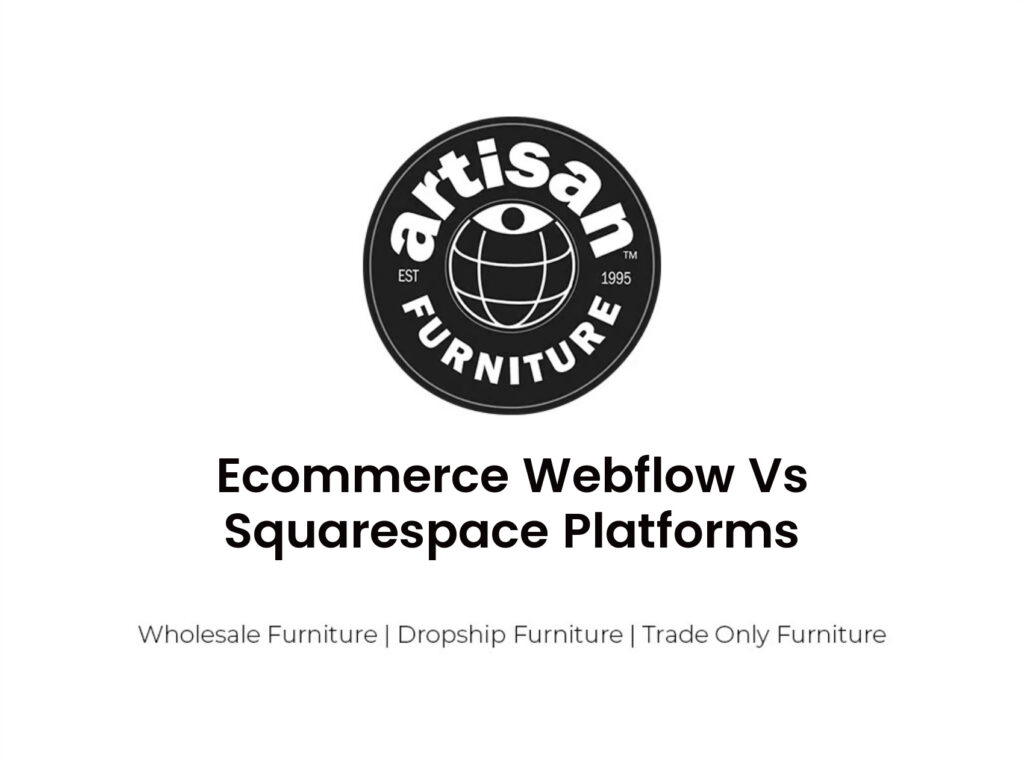Ecommerce Webflow Vs Squarespace Platforms
In the rapidly expanding world of ecommerce, businesses are constantly searching for user-friendly platforms to establish their online presence. Enter Webflow and Squarespace, two prominent contenders in this space.
This article provides a comprehensive comparison of these platforms, covering aspects such as ease of use, design customization, pricing, ecommerce capabilities, marketing tools, performance, and support. By evaluating these factors, businesses can make informed decisions that align with their goals.
Whether you prioritize simplicity, design freedom, affordability, or robust ecommerce features, this article offers valuable insights to guide your choice.
Table of Contents
ToggleEase of Use and Getting Started
When it comes to ease of use and getting started, both Squarespace and Webflow offer user-friendly interfaces and straightforward signup processes. For those looking to launch an ecommerce website, these platforms provide the necessary tools and features to get started quickly and efficiently.
Squarespace stands out for its ease of use, making it a great option for beginners. Its quick signup process allows users to choose a template, enter their email, and site title to get started right away. The platform offers a user-friendly dashboard that allows for easy customization of the website.
Webflow, on the other hand, requires a bit more technical knowledge and may not be as user-friendly compared to Squarespace. Its drag-and-drop editor can be confusing at first and may require more time to get used to. However, Webflow provides a guided tour of its template editor, making it easier for users to navigate and customize their websites.
Editing Your Site and Design Customization
When it comes to editing your site and design customization, there are a few key factors to consider.
One is the user-friendliness of the platform and the ease with which you can make changes to your site.
Another factor is the level of design freedom offered by the platform, whether it allows for extensive customization or focuses more on simplicity.
Additionally, the range of template options and flexibility in customizing them is also an important consideration.
User-Friendly Design Customization
Design customization is a crucial aspect of user-friendly website editing, allowing individuals to personalize their site’s appearance and functionality. When comparing the ecommerce platforms of Webflow and Squarespace, it is important to consider their user-friendly design customization features.
Squarespace offers a section-based template editor that makes it easy to add new elements to your site. However, precise element placement is limited, ensuring visually appealing designs.
On the other hand, Webflow provides more design freedom but requires more technical knowledge to navigate its drag-and-drop editor. With Webflow, users can customize templates, colors, border widths, and even add custom animations.
While Squarespace has better template designs, Webflow offers more customization options for those with technical expertise. Ultimately, the choice between the two platforms depends on the level of design customization desired and the user’s technical knowledge.
Design Freedom Vs Simplicity
For those looking to customize their website design, the choice between Webflow and Squarespace hinges on the balance between design freedom and simplicity.
Webflow offers more design freedom, allowing users to customize templates, colors, border widths, and even add custom animations. However, this comes at the cost of requiring more technical knowledge and a potentially steeper learning curve.
On the other hand, Squarespace prioritizes simplicity, with its section-based template editor that allows for easy addition of new elements. While design customization may be more limited compared to Webflow, Squarespace ensures visually appealing designs and offers a wide selection of impressive template designs.
Ultimately, the decision between design freedom and simplicity depends on the specific needs and preferences of the user, especially in the context of ecommerce.
Template Options and Flexibility
Both Webflow and Squarespace offer a variety of template options and flexibility in editing your site and customizing its design.
When it comes to template options, Squarespace provides 113 free world-class templates that can be filtered by industry or website type. Webflow, on the other hand, offers over 500 templates, although only a few are free.
In terms of design customization, Webflow offers more freedom but requires more technical knowledge compared to Squarespace. Webflow allows customization of templates, colors, border widths, and even custom animations.
Squarespace’s template editor is section-based and allows easy addition of new elements, but it does not allow precise element placement.
Setting Up Your Domain and Extra Costs to Consider
An important aspect to consider when setting up your domain for your ecommerce website is the cost involved in purchasing and managing the domain.
Squarespace includes a free custom domain for the first year and offers domain management within its dashboard, making it a convenient option for users. On the other hand, Webflow uses third parties like Google and GoDaddy for domain registration, which requires manual connection to your site and may involve additional costs.
While Webflow allows the use of a custom domain, the process is easier with Squarespace. It’s worth noting that free website builder plans do not allow the use of custom domains, so if you’re serious about your ecommerce business, investing in a custom domain is crucial.
Additionally, it’s essential to consider any extra costs that may be associated with your ecommerce platform, such as dropshipping fees or charges for integrating suppliers. These extra costs can vary depending on the platform and the specific services you require, so it’s important to carefully consider your budget and business needs when choosing between Webflow and Squarespace.
Pricing and Value for Money
Squarespace offers competitive pricing and excellent value for money compared to Webflow. For small to medium-sized sites, Squarespace’s cheaper plans are more suitable, providing a cost-effective option for businesses. The Personal plan, starting at $16/month, offers a range of features at a reasonable price. Additionally, Squarespace includes a free domain, storage, and bandwidth with its plans, saving users the additional cost of purchasing these services separately.
This affordability makes Squarespace an attractive choice for wholesalers in the home furniture and home decor industries. With Squarespace’s user-friendly interface and customizable templates, businesses can easily create an online presence that showcases their products and attracts customers. The platform also offers seamless integration with popular ecommerce tools, allowing wholesalers to manage inventory, process payments, and track orders efficiently.
Webflow, on the other hand, may be more suitable for developers or those with advanced technical knowledge. Its pricier plans offer more flexibility and customization options, but they may not be as cost-effective for small businesses or those looking for a simple and straightforward website solution.
Selling Online
With its robust ecommerce features and affordable pricing, Squarespace is an ideal platform for businesses looking to sell their products online. Squarespace offers a variety of tools and functionalities that make it easy to set up and manage an online store. The platform allows you to easily add and manage products, set up payment options, and customize the design of your store to match your brand.
When selling online, it is important to consider dropshipping and wholesaling suppliers. Squarespace provides integrations with popular ecommerce tools like ShipStation and Printful, which allows you to easily connect with dropshipping suppliers and streamline your fulfillment process. Additionally, Squarespace offers inventory management features that help you keep track of your stock levels and prevent overselling.
Furthermore, Squarespace provides built-in marketing and SEO tools to help you promote your online store and increase visibility in search engine results. You can optimize your product pages for search engines, create email marketing campaigns, and integrate with social media platforms to reach a wider audience.
Marketing and SEO Tools
When it comes to marketing and SEO tools, both Webflow and Squarespace offer high-quality features that are essential for growing your audience.
From alt tags and mobile-optimized designs to sitemaps, these platforms provide the necessary tools to improve your website’s visibility and reach.
Additionally, Webflow’s priciest plan includes an integrated CMS for blogging content and advanced analytics tools.
Squarespace’s priciest plan offers Gmail accounts @ your domain and the ability to tag products on Instagram.
SEO Best Practices
Marketing and SEO tools play a crucial role in optimizing website performance and increasing online visibility. Both Webflow and Squarespace offer high-quality marketing and SEO tools to help businesses grow their audience. These tools include features such as alt tags, mobile-optimized designs, and sitemaps, which are available on both platforms’ entry plans.
However, Webflow’s priciest plan includes additional features like an integrated CMS for blogging content and advanced analytics tools. On the other hand, Squarespace’s priciest plan includes Gmail accounts with your domain and the ability to tag products on Instagram.
Both platforms also offer integrations and extensions to enhance website functionality and provide a better user experience. While Webflow offers a wider range of integrations, Squarespace focuses on providing a curated selection of high-quality extensions.
Marketing Automation Features
Both Webflow and Squarespace provide a wide range of marketing automation features to enhance marketing strategies and improve SEO performance. These features are essential for growing your audience and increasing visibility in search engine results.
Both platforms offer alt tags, mobile-optimized designs, and sitemaps on their entry plans to ensure better SEO performance. Additionally, Webflow’s priciest plan includes an integrated CMS for blogging content and advanced analytics tools, while Squarespace’s priciest plan includes Gmail accounts @ your domain and the ability to tag products on Instagram.
Both platforms also offer a variety of integrations and extensions to further enhance marketing efforts. Webflow offers a vast library of integrations that can be installed manually, while Squarespace has a curated app marketplace called Squarespace Extensions with a selection of carefully chosen apps to add additional features to your site.
Performance and Security
Squarespace and Webflow both ensure a high level of performance and security for websites hosted on their platforms. These platforms understand the importance of providing a secure environment for users to conduct their online businesses. Both Squarespace and Webflow offer SSL certificates on all of their plans, which encrypt the data transmitted between the website and its visitors, ensuring that sensitive information remains protected. Additionally, both platforms guarantee a minimum uptime of 99.90%, ensuring that websites remain accessible to visitors.
When it comes to backups, Squarespace and Webflow have different processes. Squarespace automatically creates backup copies of websites and stores them on primary and secondary servers, providing peace of mind in case of any unforeseen issues. On the other hand, Webflow allows users to restore their websites to previous versions, with even the free plan allowing restoration to the last two backed-up versions.
Backups
Webflow’s backup process ensures the preservation of website data and provides users with an added layer of security. Backing up your website is crucial to protect your content and ensure that you can recover it in case of any data loss or website issues.
Webflow automatically creates backups of your website, even on the free plan. This means that you can restore your website to a previous version if needed.
Webflow allows you to restore your site as far back as the last two backed up versions. This gives you the flexibility to revert to a previous state if you make any mistakes or encounter any issues during the website editing process. Having access to backups provides peace of mind and allows you to experiment with your website design and content without the fear of permanently losing any changes.
In addition to automatic backups, Webflow also provides manual backup options. This allows you to create backups at any time, giving you full control over the backup process.
With Webflow’s backup features, you can ensure that your website data is safe and easily recoverable, providing you with the confidence to make changes and updates to your site without worrying about losing important content.
Switching Process and Help and Support
The switching process between Squarespace and Webflow can be facilitated with the help and support provided by both platforms. Both Squarespace and Webflow offer resources and guidance to assist users in migrating their websites from one platform to another.
Squarespace provides a comprehensive guide that outlines the steps involved in transferring content, ensuring a smooth transition. Additionally, Squarespace offers customer support through live chat and email, where users can seek assistance and resolve any issues they may encounter during the switching process.
Similarly, Webflow offers a detailed documentation section that provides step-by-step instructions on how to transfer content from Squarespace to Webflow. This documentation covers various aspects, including importing pages, images, and blog posts, ensuring that users have all the necessary information to successfully switch platforms. Furthermore, Webflow offers a community forum where users can ask questions and receive support from other Webflow users or the Webflow team.
Both Squarespace and Webflow are committed to helping their users during the switching process, ensuring that they feel supported and guided throughout the transition. Whether through comprehensive guides, customer support, or community forums, both platforms strive to make the switching process as seamless as possible for their users.
Frequently Asked Questions
Can I Switch Templates After Selecting One on Squarespace?
No, once a template is selected on Squarespace, it cannot be switched. It is important to carefully choose a template that suits your needs and design preferences before committing to it.
Do Squarespace and Webflow Offer Email Marketing Tools?
Yes, both Squarespace and Webflow offer email marketing tools. Squarespace has Squarespace Email Campaigns starting at $5/month, while Webflow offers email marketing features as part of its pricier plans.
Are There Any Limitations on the Number of Products and Payments on Webflow’s Ecommerce Plans?
Yes, there are limitations on the number of products and payments on Webflow’s ecommerce plans. The specific limitations depend on the plan chosen, so it is important to review the plan details to ensure it meets your business needs.
What Is the Uptime Guarantee for Squarespace and Webflow?
Squarespace and Webflow both offer at least 99.90% uptime guarantee, ensuring that your website is up and running smoothly. It is important to have an up-to-date version of your website saved and both platforms have backup options with different processes.
How Does the Switching Process Work for Existing Websites on Squarespace and Webflow?
The switching process for existing websites on Squarespace and Webflow involves manually moving content over, with most content easily imported and images needing to be reuploaded. It requires time and effort but allows for a seamless transition.



